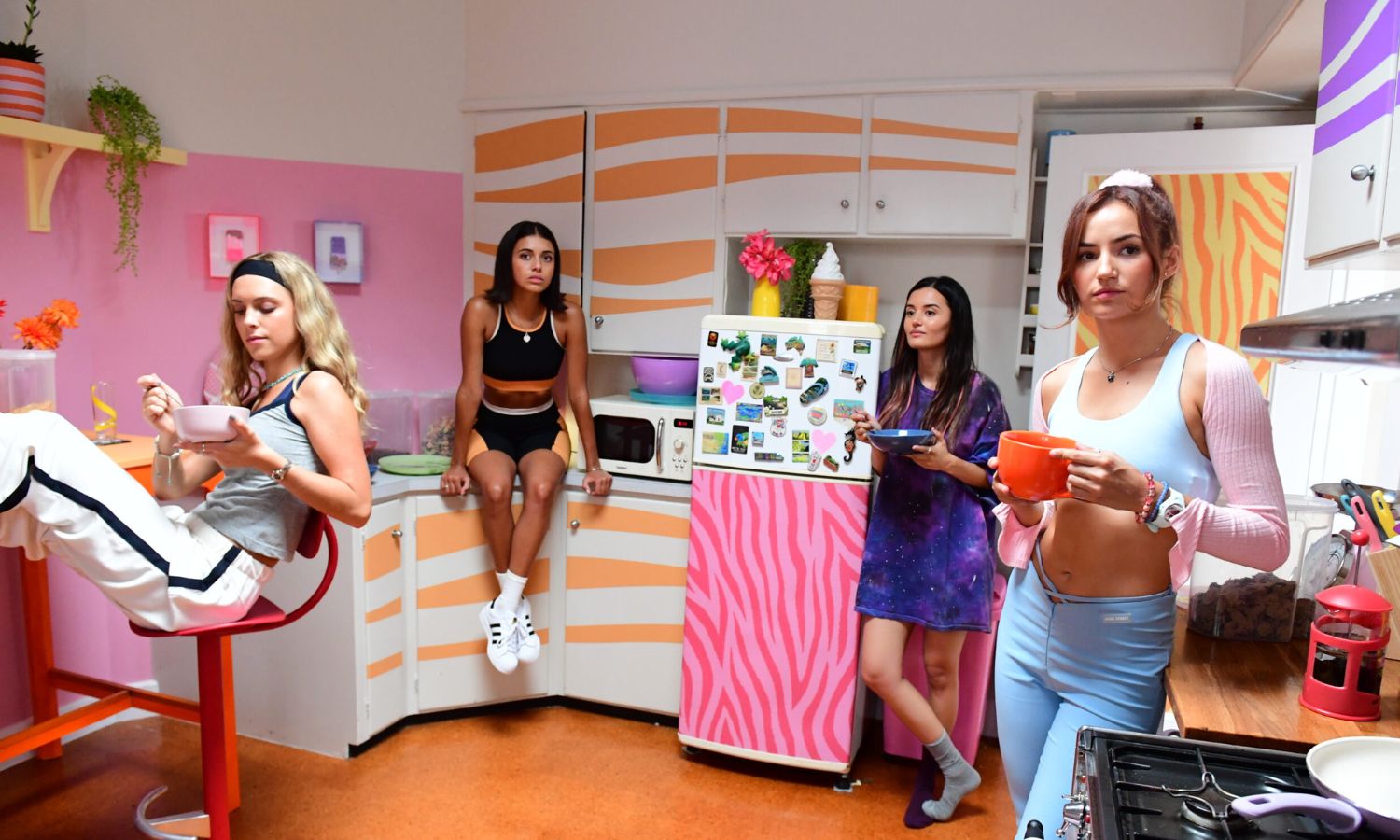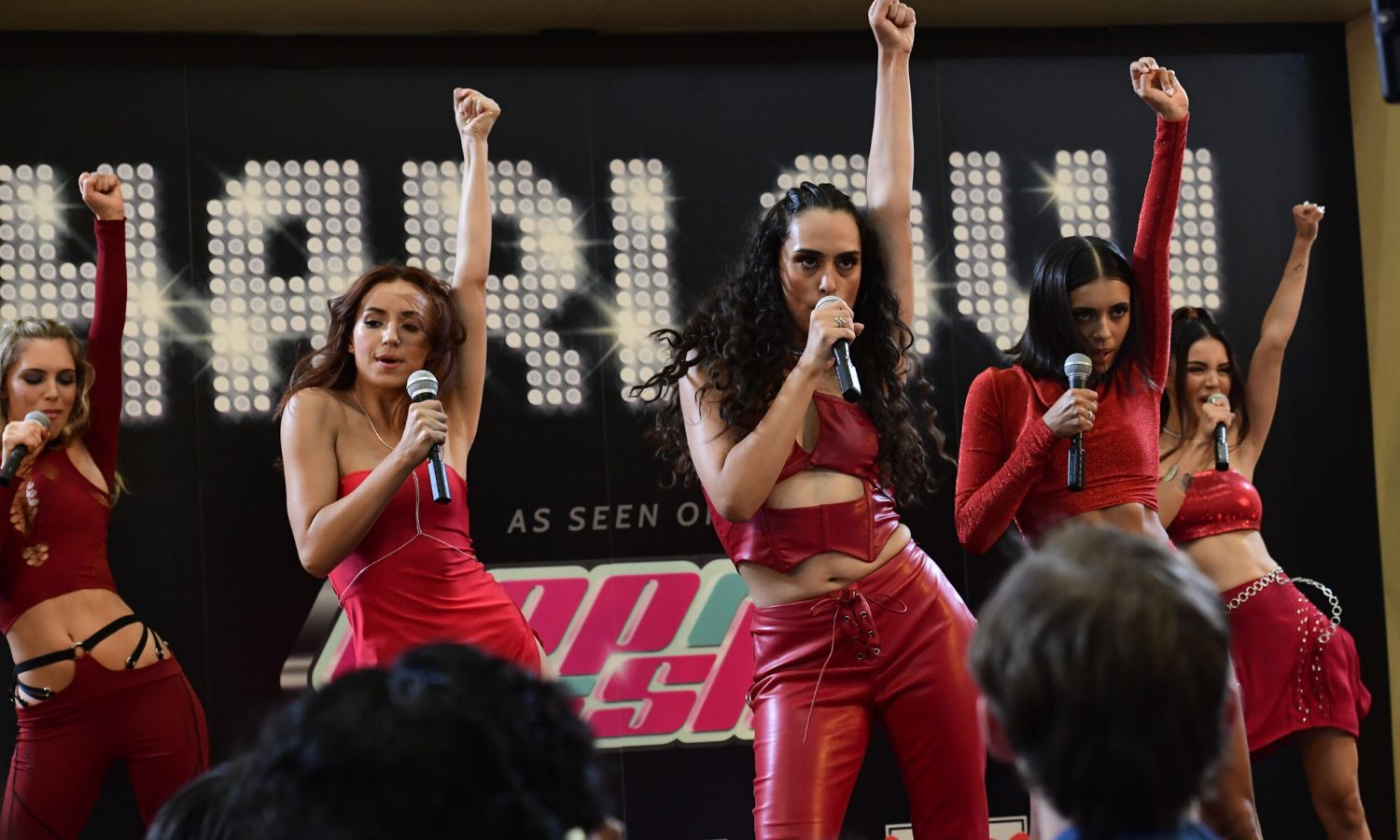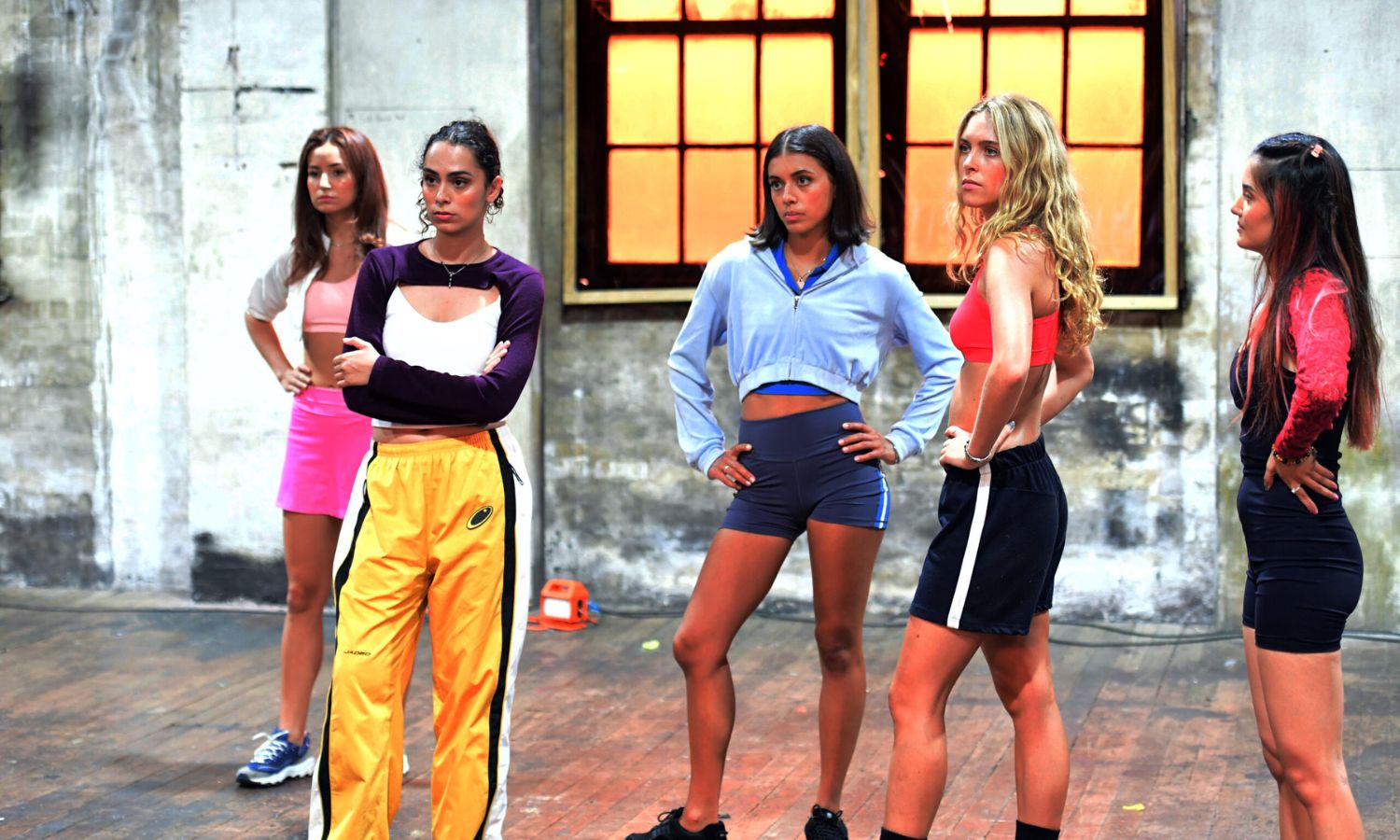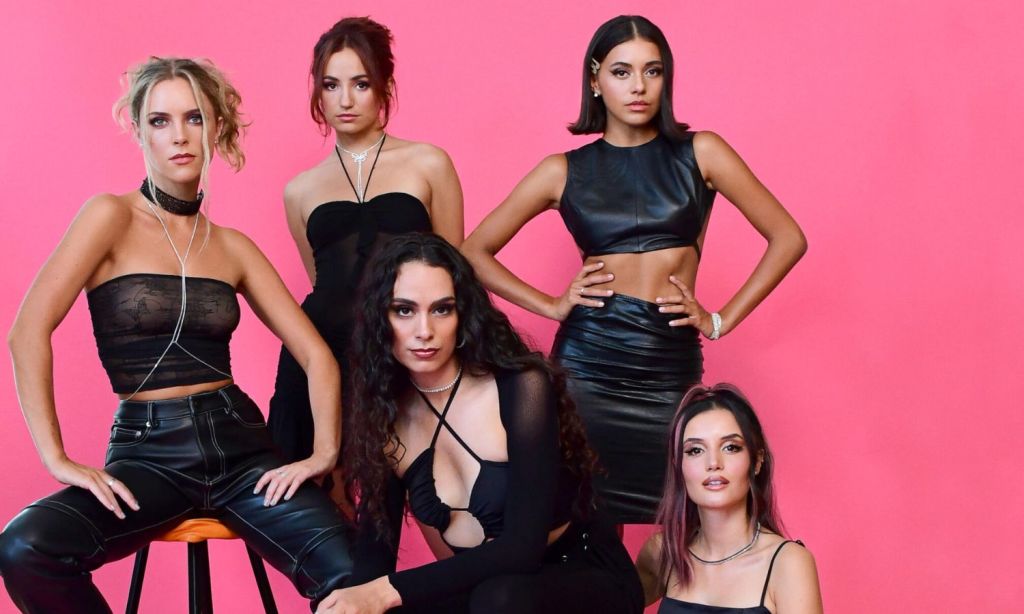As an elderly millennial, I lived and breathed Popstars as a teen. I remember watching Sophie Monk make it through the first round of auditions with her rendition of Celine Dion’s “My Heart Will Go On” after driving all night. She was the last girl to audition for the day! To me, that’s history! I saw Bardot perform “Poison” at Westfield Marion when I was 15, I owned their music, I loved them. Imagine my delight when I first heard about Paper Dolls, a girl group series with former Bardot member Belinda Chapple as an Executive Producer.
Now, the press leading up to Paper Dolls will assure you, this is not — repeat, NOT — the Bardot story. While Chapple is an EP on the series, Paper Dolls was created by Ainslie Clouston. In developing the series, Clouston has broadened its scope far beyond Bardot, with the aim of unpacking the issues that come from fast fame, as well as the abuse of power in both the music and reality television industries.
But are there similarities? Sure. Paper Dolls follows the story of HARLOW, a five-piece girl group manufactured out of the music reality series Pop Rush. But the story of Paper Dolls is darker than you’d expect. Speaking to The Latch, Clouston says it was all about getting the viewer to experience what fame, scrutiny, and abuse of power feels like.
Paper Dolls Trailer
https://www.youtube.com/watch?v=lqMJ30Cwqjs
How Many Bardot Easter Eggs to Expect in Paper Dolls
So it’s not the Bardot story, but for any fan who knows their history, there are definitely some moments that will feel… let’s say familiar. Our first episode opens with a girl getting kicked out of the group for stealing. The second episode features four of our five HARLOW members in regular clothing, while Izzy dons a phoenix costume. Did my mind immediately go to Monk’s peacock costume in the music video for “Poison“? Yes, it did! But Clouston assures me that any similarity there is purely coincidental.
“Oh my God, no!” she exclaims when I put the comparison to her. The phoenix costume is about the rebranding of the girls, and Izzy’s character arc as a phoenix rising from the ashes.
“But it’s interesting; that’s so funny!” she adds.

While they “did look at Belinda’s experience” in Bardot, the aim of Paper Dolls was always to give the show its own narrative point of view.
“We researched across all girl bands and boy bands across the world during that period, and pulled elements from everywhere,” Clouston says. “So there’s probably Easter eggs everywhere from all different things.”
Clouston adds that with the production design and wardrobe departments “pulling from such a wide assortment of visuals”, it’s likely viewers will spot Easter eggs along the way “without us intentionally dotting them through”.
Girl Groups and Boy Bands: What Went into the Creating of Paper Dolls
Having immigrated to Australia from South Africa in 2002, Clouston missed Bardot’s season of Popstars by a few years, but she did go back and watch it as Paper Dolls went into development. Like so many things from the early 2000s, it’s a different experience to watch in the current climate.
“To watch as a 33-year-old woman looking back?” she says. “It’s ‘Oh wow! This was terrifying! These girls had no idea what they were walking into’.”
Beyond watching Popstars, the research and preparation that went into Paper Dolls was extensive. Through the process, Clouston watched music documentaries and biopics, and immersed herself in the era as much as possible.
“I watched SO many music documentaries,” she says. “Because I needed to go, ‘How does this machine work? How do all the elements work together?’”
“So it was really immersing myself in it,” Clouston says. “It was so much fun, and nostalgic, but then also kind of… sad! And a bit terrifying! Because I realised that, at such a poignant time in music where female voices were being put to the forefront — Britney, Christina… the women didn’t have a voice. The female voice was being monetised, but they didn’t actually have a voice in what they were saying.”
She continues: “I was thinking about Kesha, actually, and researching her story. I was driving up to the Blue Mountains and I was listening to one of her anthems, “We R Who We R”. I just started crying! Because I was just thinking, ‘Imagine singing this song and having THOUSANDS of people singing it back to you, and seeing you, but no one knowing what you’re going through, and how lonely that must be’.
The research gave the Paper Dolls story its narrative perspective — to give the viewer the chance to sit with these pop stars, and “see how that feels as an artist”.
“Because we always watch them,” Clouston explains. “We don’t actually get to feel what it’s like.”
The Importance of Making a Story With Global Appeal
From the moment Paper Dolls went into development, the aim was clear: to create a universal story that was set in Australia, and tackle issues that affect people far beyond our shores.
“In some ways, this show could be now, and that’s the power of the show. At the core of what each girl is grappling with, it’s universal,” she says. “So I think people at home now can go, ‘I’ve experienced this’, or ‘I am experiencing this’.”
While elements of the show will be immediately recognisable to Australian viewers, Clouston wanted it to be relatable to an international audience as well. It was a strategic move that meant ensuring there was no barrier for entry in the script.

“It was interesting figuring out what words were quintessentially Australian,” Clouston recalls. “So like, ‘Dickhead’, for example, doesn’t translate! And you’re like, ‘How does that word NOT translate?’, you know what I mean?” she laughs.
With themes of fame, power, and the abuse of power in creative industries, the show leans into duality.
“It was the gloss versus the grit that we really really went for across the board,” she explains. “It’s the glossy veneer of the industry and how behind closed doors, it is just a dark, grotty hallway. And really looking at that duality in the industry, because… it’s so beautiful when you’re a couple of steps away, but as you get closer, you can see all the cracks.”
Now and Then: Paper Dolls and the Changing Face of Power
As Clouston and I chat about fame, power, and the year 2000, Britney Spears comes up more than once. A fixture in the industry since the release of “… Baby One More Time” in 1998, Spears is perhaps one of the more obvious examples of a pop icon who has been exploited — by the industry, by the media, by her family, by the public. While there has been a cultural re-evaluation of the way Spears was treated in the early days of her career, a quick scroll on TikTok can lead you down a conspiracist rabbit hole that will last for days. The question on my mind is: Have we actually gotten any better, or does exploitation just look different now?
“I think it’s a bit of both,” she says. “It’s, ‘Look how far we’ve come, or haven’t’. I think in a lot of ways, yes, we have evolved in how we look at it, but then with clickbait, with the rise in social media, with these quick shock values, have we?”
She continues: “The thing that makes it interesting to me is that you’re dealing with power, and power’s not necessarily always gendered. In the ‘90s, it was gendered — men were at the top, exploiting women’s voices, and bodies, because that’s what was making money.”
The exploitation of artists, Clouston says, is “still happening”.
“It just looks different,” she says.
What Ainslie Clouston Hopes People Take From Paper Dolls
Beyond the glitz, the glam, and a soundtrack you’ll want to add to all your playlists, Clouston hopes that viewers will want to sit with the characters and experience their struggles with them.
“You never really know what’s going on with someone; you don’t really know what someone’s going through,” she says. ” I think that’s a big one, and it’s universal. We show up and present our best selves, and what I love about these female characters is their resilience. It doesn’t matter how many times they get knocked down, these women keep getting back up, and keep staking their claim and their place.”

Beyond that, she hopes that people come to realise “how abuse of power happens in plain sight” and to have the show act as “a conversation starter”.
“That was an interesting thing for me to navigate, as a writer, because it’s not black and white. That’s why we worked so closely with the psych consultant… because we really wanted to find the grey.”
Will We Get Paper Dolls Season 2?
As we wrap up our chat, there’s just one question left to ask: Will there be a second season of Paper Dolls?
“Oh my goodness! I’m not sure!” Clouston exclaims.
“I think at the moment we’re just trying to see what people think about it,” she says. “Of course we’d love to have another season, but it all depends on how it goes, and those decisions that are made by the higher powers, you know?”
Still, she says, they “do have a concept” they could do, should they be “lucky enough to get the go ahead”.
As for whether it would follow the HARLOW story or begin with an all-new group?
“Well! I’m not allowed to say!” Clouston says.
As any pop star would say, we’ll just have to wait and see.
Paper Dolls is an eight-part series that will premiere with three episodes on Sunday, December 3, only on Paramount+. The rest of the series will drop weekly on Sundays.
Want more entertainment news? Click here to read all our content, and check out the stories below:
- Barbenheimer and Beyond: The Best Movies of 2023 So Far
- “It’s Just Inevitable”: A Mildly Terrifying Conversation About AI With Dr Catriona Wallace
- Julia Garner-Fronted Aussie Thriller ‘The Royal Hotel’ Will Screen at SXSW Sydney
- Stan’s ‘Thou Shalt Not Steal’ Features An All-Aussie Cast — Here’s What We Know
- “Never Stop Making Stuff”: Danny and Michael Philippou’s Advice for Young Creatives
- “We Can Text Ari Aster!”: Danny and Michael Philippou on ‘Talk to Me’ Success
- Australia at the Cinema: The Best Australian Films of 2023
- Retirement, Representation & Regrets: The Wiggles Reflect on 25 Years in the Spotlight
- Director Kitty Green Says That on Rewatch, ‘The Royal Hotel’ Is a Comedy
- ‘Scrublands’: Where the Stan Miniseries Was Filmed
- “Football, Factories or Prison”: How ONEFOUR Is Shifting Australian Stories
Read more stories from The Latch and subscribe to our email newsletter







